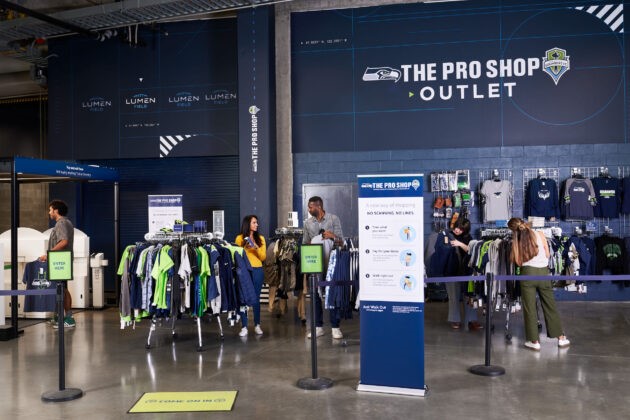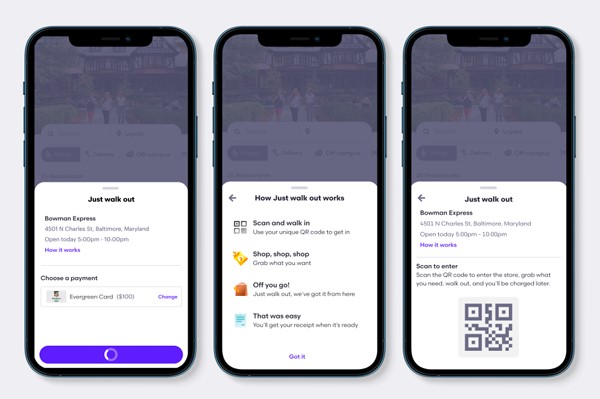The retail giant’s Just Walk Out technology now includes UHF RFID tags on garments, a reader and an antenna, and AWS to enable retailers to sell apparel with automated purchasing.
Sep 25, 2023As Amazon continues to roll out its Just Walk Out technology to enable automated points of sale, it also provides RFID technology to manage apparel purchasing. Traditionally, the company’s Amazon Go and Amazon Fresh stores and existing Just Walk Out technology sites have leveraged computer vision and generative AI to enable goods to be automatically identified as they’re sold. Now, by including soft goods, such as apparel, with the solution, the company is leveraging the unique attributes of passive UHF RFID technology to identify what product is being purchased as the shopper walks out of the store.

Jon Jenkins, VP of Just Walk Out Technology, AWS Applications
About 85 third-party stores are using Just Walk Out technology and selling merchandise supplied by Amazon. In addition, Amazon has 70 of its own stores that also leverage the system, all with computer vision and generative AI.
Stores leveraging Just Walk Out technology focus on seamless sales transactions – without queues and with minimal sales staff interactions. This includes shops in stadiums, convention centers, airports, and convenience stores. The technology enables retailers to sell everything from food and beverages to small consumer goods which shoppers carry out of the store. But some companies have also been interested in offering soft goods, such as clothing and footwear.
Moreover, an RFID-based system version has now been deployed at Seattle Seahawks’ Lumen Field stadium, Pro Shop Outlet, specifically for soft goods. Previously, with vision-based technology, the company reports that Lumen Field’s store doubled the recorded transactions. The RFID solution was also piloted earlier this year at Seattle’s Climate Pledge Arena, where the National Hockey League’s Seattle team, Kraken, plays.
In the meantime, the company is seeing interest from other stadiums, travel retailers – such as those located in airports – and convenience stores to implement Just Walk Out technology for apparel, using RFID, says Jon Jenkins, VP of Just Walk Out technology, AWS Applications.
Enabling Soft Goods Sales with RFID
Sometimes, when shoppers want to buy soft goods in “time-constrained” environments, such as at an athletic or concert, Jenkins points out, such as buying a jersey from a favorite football team during half-time. “What we heard from store owners and customers is it would be nice if they could shop for soft goods in a much more natural way,” simply selecting a product and paying for it without waiting in line.
“Creating that much more natural way to buy soft goods was something that our customers drove us to figure out a way to do,” Jenkins says. Apparel and other soft goods present technological challenges regarding automatic identification. Computer vision depends on a clear line of sight, and that's not always possible when it comes to soft goods like shirts, hats, or shoes. So Amazon looked to RFID as a potential alternative.
 Amazon’s approach has been to identify the most challenging use case and build a solution to accommodate it. For instance, picture a table with a pile of T-shirts, Jenkins says. Customers pick up individual shirts, put them back down, or move them. They may put a garment in a bag, roll it, or fold it, and (in the case of an Amazon Just Walk Out technology retail environment) leave the store. Identifying such goods with computer vision would fall short of the near 100 percent accuracy the system requires.
Amazon’s approach has been to identify the most challenging use case and build a solution to accommodate it. For instance, picture a table with a pile of T-shirts, Jenkins says. Customers pick up individual shirts, put them back down, or move them. They may put a garment in a bag, roll it, or fold it, and (in the case of an Amazon Just Walk Out technology retail environment) leave the store. Identifying such goods with computer vision would fall short of the near 100 percent accuracy the system requires.
The company had explored RFID technology in the past and gave it a second look for this use case, as RFID tags and readers have become more sensitive, have higher performance, and lower costs. “The advances in technology made it a natural fit for enabling certain types of [identification] that had been challenging for the cameras,” Jenkins says. Each RFID tag is encoded with a unique identification and, when read, provides a link to that item in the Amazon Web Services (AWS) cloud software. In this way, the technology can ensure specifically what item is being read, even if there isn’t a clear line of sight.
The global retailer worked with Avery Dennison to build the RFID solution that leverages the company’s tags, along with an array of purpose-built antennas and reader architecture created by Amazon.
With Avery Dennison, Jenkins says, coordination and testing resulted in the high read performance the system required. “Their tag design made it possible to gain the accuracy and speed that we weren't sure was possible until they showed us.”
How it Works
First retailers need an RFID tag on their products. Today many of Amazon’s retailer customers are receiving apparel already tagged by the manufacturer, while others are not.
Therefore, Amazon can provide RFID tagging services, printers, and related technology so that the retailers can do it themselves as new merchandise is received. Once the tag is applied and commissioned, the data is stored in the AWS system. Amazon provides the RFID-enabled exit gate with an antenna array, and a reader explicitly installed for that customer site and merchandise.
Once the system goes live, it begins identifying tags within the range of the reader. The solution leverages the antenna configuration and the existing machine-learning algorithms to read tags and calculate what is happening with them. For instance, the solution identifies when a tag is being removed from the store, instead of coming inside, or simply on display in the store, within range of the reader.
“These environments are incredibly complex,” Jenkins says of its customer stores. He points to the example of a sports stadium shop in which dozens of people may move around a relatively small space, with items in their hands – all of which have tags on them. The antennas at the exit gate may capture most of these tag IDs.
 Customers who arrive at stores using the RFID system do not need to be identified. They enter the store, browse the soft goods, select one or more items, and proceed to the exit. There, they tap their credit card against a reader or have their palm scanned. The system identifies their payment method and links that account with the tagged products that are being removed.
Customers who arrive at stores using the RFID system do not need to be identified. They enter the store, browse the soft goods, select one or more items, and proceed to the exit. There, they tap their credit card against a reader or have their palm scanned. The system identifies their payment method and links that account with the tagged products that are being removed.
Next, the exit gates open and the customer walks through with their purchases. There is no screen displaying the products they have bought, instead, users can either go to the store or the Amazon website to view their purchase.
Retailers are now working with Amazon to open the RFID-enabled version of Walk Out at several locations which can be expected to open in the coming months.
The solution is designed for ease of deployment, Jenkins says. Users pay a monthly fee for the AWS-based, point-of-sale data. Because the only infrastructure requirements are the exit gate reader and antenna arrays, Amazon can offer the solution at a price point well below that of the computer-vision-enabled systems.
“I think this is going to open up Just Walk Out shopping to a whole new range of stores that may have thought it was prohibitive before,” Jenkins says.
He adds that RFID provides other opportunities in the future, such as authentication in cases where high-value items such as team jerseys could have sewn-in labels that prove the jerseys are not counterfeit. In this case, the same tags could provide multiple benefits. “If you’re a company that has your jerseys manufactured with RFID tags embedded in them, we can read those tags at our exit gates without a separate tag being applied,” Jenkins says. In the meantime, “Every day there seems like there's some new advance in RFID that makes it work in more and more places.”
In the long term, Amazon expects to offer hybrid solutions that could offer both computer vision and RFID as needed. “We'll draw the line wherever it makes most sense for a particular store,” he explains.
Key Takeaways:
- Amazon is deploying RFID technology for apparel or other soft goods sales at stores using the company’s Just Walk Out solution.
- While a Seattle Seahawks store in Lumen Field is the first to use the solution with RFID, the company says more stores will be going live in the coming months.

